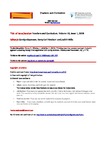Thinking about bus journeys to school: A playful approach to working through lived experiences with young travellers
| dc.contributor.author | Gristy, Cath | |
| dc.contributor.author | Whalley, J | |
| dc.contributor.author | Miller, Lee | |
| dc.date.accessioned | 2020-01-02T19:28:30Z | |
| dc.date.available | 2020-01-02T19:28:30Z | |
| dc.date.issued | 2018-05-31 | |
| dc.identifier.issn | 2382-0349 | |
| dc.identifier.issn | 2382-0349 | |
| dc.identifier.uri | http://hdl.handle.net/10026.1/15276 | |
| dc.description.abstract |
Getting from home to school is an integral part of each day for young people. The school day starts and ends with a journey, whether this be by foot, on a bike, in a car or in larger scale private or public transport vehicles. For some young people and their families, this journey is easy and maybe even fun, for some it might be a nightmare. The journey to school can be a short hop or a long haul. Each individual has their own particular journey to school but what unites the individual student stories is a general lack of acknowledgement of these experiences by staff in the school they attend. Perhaps a reason for this is that the journey to school lies in a space between, a space between home and school. For staff, the school day begins when the students arrive on the school site, as this is when their responsibility begins. However, for students, the journey from home is integral to their school day, so it could be argued that for the young travellers their school day has begun before they reach the site, and it may not have started in a way that makes them ‘ready for learning’. In this piece, we are thinking about journeys to school by bus and more specifically, those journeys made by high school students; young people aged 11 to16 or 18 years old. | |
| dc.language.iso | en | |
| dc.publisher | University of Waikato | |
| dc.title | Thinking about bus journeys to school: A playful approach to working through lived experiences with young travellers | |
| dc.type | journal-article | |
| plymouth.issue | 1 | |
| plymouth.volume | 18 | |
| plymouth.publication-status | Published online | |
| plymouth.journal | Teachers and Curriculum | |
| dc.identifier.doi | 10.15663/tandc.v18i1.327 | |
| plymouth.organisational-group | /Plymouth | |
| plymouth.organisational-group | /Plymouth/Faculty of Arts, Humanities and Business | |
| plymouth.organisational-group | /Plymouth/REF 2021 Researchers by UoA | |
| plymouth.organisational-group | /Plymouth/REF 2021 Researchers by UoA/UoA23 Education | |
| plymouth.organisational-group | /Plymouth/Research Groups | |
| plymouth.organisational-group | /Plymouth/Research Groups/Institute of Health and Community | |
| plymouth.organisational-group | /Plymouth/Users by role | |
| plymouth.organisational-group | /Plymouth/Users by role/Academics | |
| dcterms.dateAccepted | 2018-05-01 | |
| dc.rights.embargodate | 2020-11-5 | |
| dc.identifier.eissn | 2382-0349 | |
| dc.rights.embargoperiod | Not known | |
| rioxxterms.versionofrecord | 10.15663/tandc.v18i1.327 | |
| rioxxterms.licenseref.uri | http://www.rioxx.net/licenses/all-rights-reserved | |
| rioxxterms.type | Journal Article/Review |


